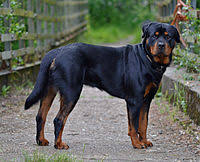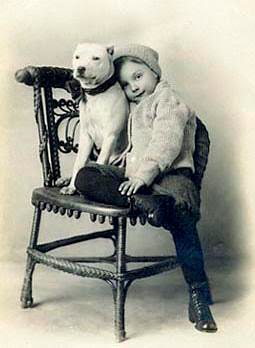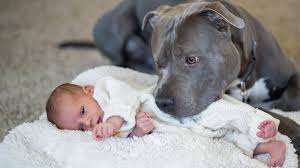The TSA uses about 1200 dogs at airports to screen passengers and baggage. These dogs are from seven breeds, two of which have pointy ears, including German Shepherds. But four out of five of the recent additions to the canine corps have droopy ears. Why?
Because the TSA decided, purely anecdotally, that people generally view floppy-eared dogs as more docile and friendly and pointy-eared dogs as more aggressive.
Allegedly, floppy-eared dogs don’t scare children but the pointy-eared dogs do.
There is some research that supports the idea that people view pointy-eared dogs as more intimidating. This is a totally unsupported prejudice and it’s unfair to dogs because many dogs with pointy ears have had their naturally floppy ears cropped as puppies. Others have been genetically engineered by breeders to look that way.
Let’s be clear – pointy ears do not indicate an aggressive or dominant temperament. Ear configuration has no relationship to a dog’s disposition. This fear of pointy-eared dogs has been called ‘canine racism.’
I know a lot about doggie discrimination.
My daughter, Sarah, works with a Pit Bull rescue group in LA called Angel City Pit Bulls. One of their missions is to fight breed discrimination, like breed specific legislation which prohibits Pits from certain buildings and even certain cities. London had a Pit Bull ban and Montreal is trying to enact one. This forces people to choose between living where they want and giving up their beloved pet or finding somewhere else to live with their dog.
Pit Bulls are the canine ‘bad guys’ du jour. In the past, German Shepherds were shunned as aggressive and dangerous but now are used as companions and seeing-eye dogs. Then Rottweilers became the ‘bad dog’ du jour — and they don’t even have pointy ears!
In the late 1800s and early 1900s, Pit Bulls were used as the ‘nanny’ dog – to protect children and be their early companions. They were considered the ideal family pet and many family photos from the period include young children with their Pit Bulls.
What’s even more galling about Pit Bull discrimination is that ‘Pit Bull’ isn’t even a legitimate breed. It’s an umbrella label that encompasses dogs from at least four different breeds, including Staffordshire Terrier, Staffordshire Bull Terrier, and the American Bulldog.
In shelters, dogs are labeled ‘Pit Bull’ if someone thinks they have some Pit Bull in them. The designation is totally arbitrary and subjective. And there are more Pits in shelters than any other breed and they are euthanized at a higher rate than any other breed.
To add insult to injury, the breeds that make up the faux category ‘Pit Bull’, are smack in the middle of the ratings for aggressiveness by breed. They are rated between Labs and Golden Retrievers! Clearly, these dogs are nowhere near being the most aggressive dogs.
In fact, the two most aggressive breeds are Chihuahuas and Dachshunds. But no one lodges complaints when attacked by a Chihuahua, probably because it would be embarrassing.
The most dominant traits in Pit Bull breeds are their gentleness and sweetness, their friendliness and their desire to please their humans. They got a bad reputation decades ago when dog fight promoters started training Pit Bulls to fight.
Remember, any dog can be trained to be aggressive and fight. And Pits are especially trainable because of their desire to please. Many Pits who have been rescued from dog fighting rings have been successfully rehabilitated and have been adopted as family pets – even after being trained to be aggressive.
So there is no basis for the widespread perception that Pit Bulls are more dangerous than other breeds. There is also no basis for the perception that pointy-eared dogs should be feared more than floppy eared dogs.
People seem to need to discriminate. They discriminate against people and dogs. We should fight prejudice and discrimination wherever we find it, even when it’s dogs. Mostly, dogs are nicer than people anyway.
Support dogs!
Categories: #Photography, dogs











 MIDWEEK MADNESS: A CLOSEUP AND MACRO
MIDWEEK MADNESS: A CLOSEUP AND MACRO  TOUGH DECISIONS
TOUGH DECISIONS  JUNCO, DOGS WITH A HORSE
JUNCO, DOGS WITH A HORSE  NOW THAT’S FUNNY
NOW THAT’S FUNNY
Dogs Rule! ❤ I have one of each – one sharp eared and one floppy eared. Neither are aggressive, and both have strains of chihuahua in their mix. Huny (my chihuahua who passed away last year) was the most aggressive dog I ever had, but Gypsy (my standard dachshund who died in 2013) was also a very protective 'mommy's girl'. Gypsy looked more intimidating – she was almost 50 lbs at her peak, and being long haired looked bigger. People who approached me would be greeted by her with a mile long stare and a curled lip, and a low constant growling. If I gave the person the nod, then Gypsy would generally relax. If she did not, I had second thoughts about letting the person approach me. Dogs aren't fooled by the friendly facade. Hunydog would bite. Even though she was 10 lbs at her top weight, people were more scared of her than any dog I've ever owned. And her bite was sharp. I would warn folks who thought she was cute and a lap dog that she was NOT. She usually snapped at people, and they would soon learn. Judging a dog on its ear configuration is as dim-witted (to me) as someone who judges another person based on skin color.
LikeLike
Dog predjudice is just as irrational as predjudice against other humand because of their skin color, race or religion, or even their sex or sexual preferences. But predjudice has existed as long as the human race and we have to fight it wherever we see it – whether against people who are ‘different’ in some way, or against dogs who have today’s designated ‘bad’ breed or physical traits.
LikeLiked by 1 person
Marilyn pointed out the ear difference in terriers. Norwich versus Norfolk. Divot, my long ago love, was a Norwich. I adored her.
LikeLike
You’re probably preaching to the choir here but perhaps some uninformed person may read this and actually develop an informed opinion! Me, I love dogs, I swear they are the sweetest creatures on the planet – especially Pitties and Rotties.
LikeLike
It would be nice if someone could be ‘cured’ of their predjudice by just reading an article. That may work with dogs, but people’s innate biases against other people are deep seeded and can be very hard to eradicate.
LikeLike
I never thought about this issue until, I think Ellin mentioned it in one of her posts. Funny how people develop these prejudices.
Leslie
LikeLike
These dog predjudices are even funnier when you look back and see the progression of dogs that have been vilified and then resurrected over the years. Now Rottweilers and German Shepards are in favor and Pit Bulls are out. In the early 20th century, it was the other way around. It’s like targeting Mexicans for predjudice today and then switching to Germans tomorrow.
LikeLiked by 1 person
truly sad…
LikeLike
Sorry, a word got lost. Pls read….. same normally very pleasant for bit my son’s FRIEND’S sister….
LikeLike
A very interesting and important posting. Had never really thought about it, so directly. However, I agree. Floppy ears just look cuter. 😉 Michael
LikeLike
Breed discrimination is really terrible. Some buildings and even some cities ban Pit Bulls so people have to get rid of the family dog or deal with a limited search area for a place to live.
LikeLiked by 1 person
So true, and so sad, too. Thank you for mentioning. Michael
LikeLike
Very important post. Dogs ARE nicer than peoople….
One aunt had a German sheppard and I, as a child, loved her unconditionally. And yet, I got not bitten but nipped. Turned out that she got ‘moody’ with old age and couldn’t be let nr kids any longer. My son, always around dogs, got bitten by a usually docile Danish Dogge and had a large chunk of his upper arm taken off when he was five. We all couldn’t understand it. The friend’s parents got a strong warning and had to build a high fence around their property. Then the same normally very pleasant dog bit my son’s sister – badly, again. He had to be killed, and a tumour was found….. Our own dachshund never, eveer, hurt a child but wouldn’t accept bad treatment by any adult. It’s really the owners who are mainly responsible for bad behaviour in dogs. Friends in UK with a very well run B&B bought a Staff, a huge white beast to look at. The owners who knew that we adored dogs, introduced us to him and we had great interaction. BUT they had the dog to protect them and their property. Before they had this menacing looking pet, they got broken into, never since. Vive les pets!!!! and thanks for sharing all the good news about them, many ppl don’t know most of what you write. Give your daughter a Thank You too please.
LikeLike
All dog breeds have some dogs that have bad tempers or are aggressive and any dog of any breed can bite. But you can’t judge a dog by it’s breed alone. How it is treated through its life is an important factor, as are its inherent temperament and the situations it is placed in.
LikeLike
Agree. If you got another impression I apologize. But even with great knowledge and the best intentions, accidents can happen
But NEVER blame the dog!
LikeLike
Yes, there is doggy discrimination and it’s very sad that people do this and foster the idea of breed-specific laws. I did not know that these dogs were once popular as “nanny” dogs. More people should be made aware of that.
LikeLike
People are shocked today to learn that the beloved German Shepard of police dog and seeing eye dog fame, was maligned as a dangerous animal just a generations or so ago. They are equally shocked to learn that Pit Bulls were the favored pet of families with small children in the late 19th and early 20th centuries.
LikeLiked by 1 person
Very informative, Ellin. Thanks! Yes, many dogs are nicer than people:)
LikeLike
It also used to be assumed that once a dog was taught to be aggressive, they could never be ‘trusted’ with people. That is also a myth. Many dogs who were trained to fight other dogs in dog fighting rings, have been rehabilitated and are now family pets. Dogs have an amazing capacity for recovery from often brutal situations. They inherently love and trust people and with the right care, most dogs can be given happy lives in homes, as long as you respect their inherent nature and limitations – some dogs are not good with cats or other dogs, some aren’t good with young children, etc.
LikeLiked by 1 person
All makes sense!
LikeLike